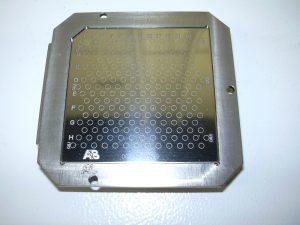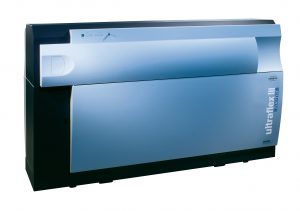Glycosylation, the process of adding carbohydrate molecules to proteins and other biomolecules, is one of the most common post-translational modifications found in living systems. By some estimates, over 50% of proteins found in the human body have been modified by glycosylation. A great number of glycosylation pathways exist, as their variety is not just limited to the identity of the sugar; they can also differ by linkage (O- or N-linked glycans), chain length (how long or short the polysaccharide linkages are), and the branching of the glycan chain. Glycosylated molecules play an essential role in cellular recognition, as it is the cell-surface glycans that cells use to differentiate themselves from one another. This can be exploited to determine the health of an individual cell and the organism as a whole, as certain inherited disorders, acquired (non-inherited) diseases, and cancers have specific cell-surface glycan profiles. Accurate identification, categorization, and detection of these glycans can improve diagnoses and guide practitioners towards the most effective therapies for their patients.
Matrix Assisted Laser Desorption Ionization (MALDI)

Mass spectrometry (MS) is a powerful tool for the analysis of molecules. Molecules are ionized within a magnetic field, causing them to accelerate towards and collide with a detector plate. The acceleration of the molecule is determined by its mass and charge; if one knows the charge, the mass can be determined by the detector signal that corresponds to its acceleration. The simplest method for molecular ionization is electron impact, where high energy electrons collide with the molecule to generate a charged species. The downside to this method is the high chance of fragmentation (bond-breaking) of the target molecule. Though this fragmentation may be beneficial for the study of smaller organic molecules, as these fragments can be diagnostic of certain functional groups, the spectral complexity induced by this fragmentation would quickly become overwhelming for larger, more complex analytes. For large biomolecules, such as glycoproteins or glycolipids, a gentler ionization method with minimal fragmentation is desired; Matrix Assisted Laser Desorption Ionization (MALDI) is a method that achieves this. A solution of the analyte is embedded (dissolved and allowed to dry) in a matrix on a scrupulously-cleaned metal sheet called a MALDI plate (pictured left). The matrix is typically composed of organic molecules that contain conjugated electrons and at least one acidic proton (for acid-sensitive samples, basic matrix molecules are also available). Shining a powerful laser on this analyte-matrix mixture will cause desorption, where the analyte is released from the surface surrounded by a layer of matrix molecules. Once desorbed, matrix molecules will induce a charge on the analyte, either by protonation or deprotonation depending on the matrix component. Now charged, the analyte will come under the effects of the magnetic field present within the mass spectrometer, accelerating towards the detector plate.
Time of Flight (TOF) Mass Spectrometry (MS)

The previous paragraph focused on the ionization of the analyte of interest prior to mass spectrometer introduction, but what about the mass spectrometer itself? For MALDI instrumentation, one such mass spectrometer set-up would include a Time of Flight (TOF) MS (pictured right). In this system, the detector is a known distance away from the ion source. The analyte, once ionized at the ion source, will accelerate towards and collide with the detector; the time that the analyte takes to reach the detector will be determined by its mass-to-charge ratio. If one knows the charge of the ion, a mass can be accurately determined from this time of flight. This mass can be used to determine of the identity of the ion in question. Advantages of TOF over other mass spectrometry layouts include increased accuracy and mass resolution, greater sensitivity, and increased dynamic range when looking at a broad range of molecular masses.
Glycan Extraction and MALDI: Applications and Automation
Prior to MALDI-TOF-MS analysis, the glycan component needs to be cleaved from the protein that it is covalently bonded to; both chemical and enzymatic pathways exist for the extraction of glycans from their parent proteins. Once these extractions are complete, isolation of the glycan itself can be conducted using solid phase extraction (SPE). In this situation, for example, the solid phase sorbent will selectively bind the glycans that are present in solution under neutral conditions, but will release them under acidic conditions, allowing for the separation of the glycans from the bulk solution. Following isolation, the analyte may have to be dissolved in an alternative solvent that is compatible with mass spectrometry, necessitating a drying step. For MALDI plating, the matrix and analyte mixtures need to be carefully added to the MALDI plate, with the order and timing of these additions playing an important role in the quality of the resulting mass spectrum.
All these steps require manual intervention and can be very time-consuming. Cleaving of the glycan may include a number of addition, mixing, heating, and incubating steps. The SPE process requires column condition, sample loading, washing, and eluting, with these steps including equilibration between additions. For MALDI-spotting, the plating of the samples is a delicate and laborious endeavor, which requires keeping track of the analyte and matrix mixes on the plate. For these reasons, many labs are turning towards automated liquid handling workstations to automate their sample preparation for mass spectrometry analysis. These systems increase workflow and throughput, improving overall laboratory efficiency and sample turnaround times. If you would like to know more about how these liquid handling workstations can streamline your processes, contact our team at Aurora.


